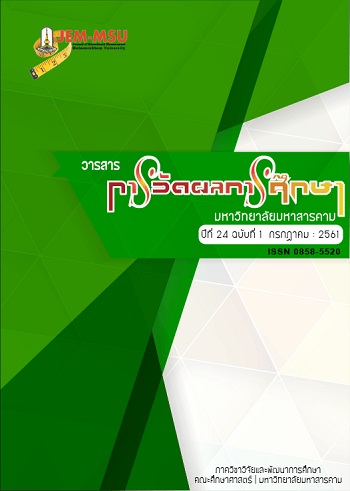The Development of Problem-based Learning to Develop Learning Achievement.Of Undergraduate Students Institute of Physical Education UdonThani Campus.
Main Article Content
Abstract
An organization of effective learning activities and compatible with principles of
child-centered, teaching activities should be developed students’ reasoning abilities, creative
thinking, problems solving abilities, and knowledge applying more valuable in real situations.
The purposes of this research were to (1) find the effectiveness of problem-based learning
efficiency of 75/75 , (2) find the effective index value of problem-based learning, (3) compare
achievement of measurement and evaluation between learning by the teaching-learning
problem-based learning and regular teaching , (4) study students' satisfaction with problembased teaching and learning of undergraduate students at Institute of Physical Education
Udonthani.
The sample used in this study was 3rd year Udonthani undergraduate students in the
course of GE 042007 Measurement and Evaluation in Education during the second semester
in 2016 academic year of Institute of Physical Education Udonthani. The whole students
were 67 people of two classrooms by using cluster random sampling to experiment group of
36 people and using control group of 31 people. The instruments used in this study were 9
teaching plans of problem-based learning and the traditional teaching multiple choice test of
20 items with discrimination of 0.25 – 0.67 and a reliability of 0.83, satisfaction questionnaire
of undergraduate students towards the problem-based learning, rating scale of 5 level
including 13 items that provided value of each item (rxy) from 0.49 – 0.75 and the reliability
of 0.87, and strategy used to analyze the data such as arithmetic mean, percent, standard
deviation and hypothesis testing with t-test (independent samples)
The research results were as follows.
1. The results of the effectiveness of problem-based learning of undergraduate
students at Institute of Physical Education Udonthani was 78.37/76.47
2. The effective index value of problem-based learning of undergraduate students at
Institute of Physical Education Udonthani was 0.6109 that showed the percent of 61.09
3. Students were taught by using the problem-based instruction in Measurement
and Evaluation subject of undergraduate students at Institute of Physical Education
Udonthani were more achievable than the ones who taught by using the conventional
learning and the significance of their strategy was .05.
4. Students were taught by using the problem-based instruction in Measurement
and Evaluation subject of undergraduate students at Institute of Physical Education
Udonthani were very satisfied ( x = 4.39)
Article Details
The content and information contained in the published article in the Journal of Educational Measurement Mahasarakham University represent the opinions and responsibilities of the authors directly. The editorial board of the journal is not necessarily in agreement with or responsible for any of the content.
The articles, data, content, images, etc. that have been published in the Journal of Educational Measurement Mahasarakham University are copyrighted by the journal. If any individual or organization wishes to reproduce or perform any actions involving the entirety or any part of the content, they must obtain written permission from the Journal of Educational Measurement Mahasarakham University.
References
จันทรเกษม.ถ่ายเอกสาร.
2.เบญจมาศ เทพบุตรดี. (2550). การเปรียบเทียบผลสัมฤทธิ์ทางการเรียน ความสามารถในการคิดวิเคราะห์
และความสามารถในการให้เหตุผลทางคณิตศาสตร์ ของนักเรียนชั้นประถมศึกษาปีที่ 6 ระหว่างการ
จัดการเรียนรู้โดยใช้ปัญหาเป็นฐาน (PBL) และการจัดการเรียนรู้แบบปกติ เรื่อง การบวก ลบ คูณ
หาร ทศนิยม.วิทยานิพนธ์ กศ.ม. มหาสารคาม : มหาวิทยาลัยมหาสารคาม.
3. ปราณี หีบแก้ว. (2552). การพัฒนาความสามารถในการแก้ปัญหาและผลสัมฤทธิ์ทางการเรียนวิทยาศาสตร์
เรื่องทรัพยากรและสิ่งแวดล้อม ของนักเรียนชั้นมัธยมศึกษาปีที่ 3 โดยการจัดกิจกรรมการเรียนรู้
แบบใช้ปัญหาเป็นฐาน. วิทยานิพนธ์ กศ.ม. ขอนแก่น : มหาวิทยาลัยขอนแก่น.
4. พงศธร ทิพรักษ์. (2554). การเปลี่ยนแปลงมโนมติทางวิทยาศาสตร์ เรื่อง แรง มวลและกฏการเคลื่อนที่ของ
นักเรียนชั้นมัธยมศึกษาปีที่ 4 โดยใช้รูปแบบการเรียนรู้แบบใช้ปัญหาเป็นฐาน. วิทยานิพนธ์ กศ.ม.
ขอนแก่น : มหาวิทยาลัยขอนแก่น.
5. พัชรินทร์ ชูกลิ่น. (2554). การใช้วิจัยเชิงปฏิบัติการในการพัฒนากิจกรรมการเรียนรู้แบบใช้ปัญหาเป็นฐาน
วิชาชีววิทยา เรื่องเคมีพื้นฐานของสิ่งมีชีวิตของนักเรียนชั้นมัธยมศึกษาปีที่ 4. วิทยานิพนธ์ กศ.ม.
ขอนแก่น : มหาวิทยาลัยขอนแก่น.
6. ศุภิสรา โททอง. (2547). การเปรียบเทียบผลการเรียนรู้ระหว่างการสอนโดยใช้ปัญหาเป็นฐาน (PBL) กับ
การสอนตามคู่มือของ สสวท. กลุ่มสาระการเรียนรู้คณิตศาสตร์ เรื่อง การวัดความยาวในระดับชั้น
ประถมศึกษาปีที่ 4. การศึกษาค้นคว้าอิสระ กศ.ม. มหาสารคาม : มหาวิทยาลัยมหาสารคาม.
7. สุวิทย์ มูลคำ. (2542). วิธีจัดการเรียนรู้ : เพื่อพัฒนากระบวนการคิด. กรุงเทพฯ : ภาพพิมพ์.
8. อมรวิชช์ นาครทรรพ.(2543). วิถีทัศน์เพื่อพัฒนาอุดมศึกษาไทยในศตวรรษที่ 21 .วารสารครุศาสตร์.
จุฬาลงกรณ์มหาวิทยาลัย ฉบับที่ 2 เลขหน้า 2 – 28.
9. อุไร คำมณีจันทร์. (2552). การเปรียบเทียบผลสัมฤทธิ์ทางการเรียน ความสามารถในการแก้ปัญหาทาง
วิทยาศาสตร์ ของนักเรียนชั้นมัธยมศึกษาปีที่ 3 ระหว่างการจัดการเรียนรู้โดยใช้ปัญหาเป็นฐาน
(PBL)กับการจัดการเรียนรู้แบบวัฏจักรการสืบเสาะหาความรู้ 5 ขั้นและการจัดการเรียนรู้แบบ
กลุ่มร่วมมือ. วิทยานิพนธ์ กศ.ม. มหาสารคาม : มหาวิทยาลัยมหาสารคาม.
10. Ahlfeldt, Stephanie L.(2004). “Probem-based Learning in the Public Speaking Classroom,”
Dissertation Abstracts International. 65(1) : 21-A ; July.
11. Brennan, R.L. (1972). “A Generalized Upper-Lower Discrimination Index”, Educational and
Psychological Measurement. 32 (Summer 1972) , 289 – 303.
12. Cronbach, L.J. (1951). Coefficient alpha and the internal structure of tests. Psychometrika,
16 (3), 297-334.


